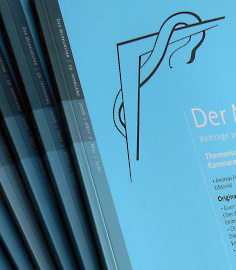
HEFT 4/2023
Der Merkurstab | Juli/August 2023 | 22,00 Euro (inkl. Mwst., zzgl. Versandkosten)

| Artikel | Der Wandel des Materiebegriffs in
der Physik seit dem 19. Jahrhundert The change of the concept of matter in physics since the 19th century |
| Autor | Wolfgang Häußler |
| Seiten | 236-247 |
| Volume | 76 |
Zusammenfassung
Der Weg von der klassischen zur modernen Physik ist eng mit
einer Wandlung des Materiebegriffs verbunden. Am Beginn des
20. Jahrhunderts erscheint das Materiebild des physikalischen
Denkens in einer gegenüber dem Atombegriff der Antike völlig
neuen Form. Auslöser dieses Umschwungs sind notwendige
Korrekturen in der mathematischen Formulierung von Zusammenhängen
auf verschiedenen physikalischen Gebieten. Diese
Entwicklung geht einher mit dem Sammeln experimenteller
Daten, die eine Vielfalt an Handlungs- und Manipulationsmöglichkeiten umfassen.
Einerseits tritt in dem sich an einer konsistenten Mathematik korrigierenden Denken eine zukunftsweisende Fähigkeit
auf. Es wird fähig, den Menschen als mit der Welt verbunden
zu begreifen. Andererseits entwickelt sich der Bezug zur Welt
in einseitiger Weise. Der mit den physikalischen Begriffen
greifbare Weltinhalt verliert fast jeden Inhalt, bis nur noch
abstrakte, mathematisch formulierbare „Zustände“ übrig
bleiben.
Der tiefere Grund für diese Entwicklung liegt in einer immer
stärkeren Fokussierung auf eine quantitativ beschreibbare und
messbare Ebene der Welt, die hinter den sinnlich erfahrbaren
Naturprozessen verortet wird. Immer deutlicher wird die Einseitigkeit einer Wissenschaft, die in nie dagewesener Weise
technische Entwicklungen ermöglicht, jedoch beim Vermessen
der Welt den menschlichen Lebensbereich mit seiner Fülle an
erfahrbaren Qualitäten und damit zugleich die Auswirkungen
der entwickelten Technik aus den Augen verliert. Schließlich
verliert sie auch die Vorstellung der Materie selbst.
Die Alternative wäre eine Wissenschaft, die in die zunächst
verborgenen Dimensionen der Welt in bewusster Weise eintaucht.
Die Quantenphysik legt hierfür Grundlagen, indem
sie im Verlieren der Materievorstellung ein Denken entwickelt,
das sich von einem inneren Konsistenzerleben führen lassen
und dadurch neue Begriffe bilden kann.
Abstract
The path from classical to modern physics is closely connected
with a change in the concept of matter. At the beginning of the
20th century, the concept of matter in physical thinking appears
in a completely new form compared to the atomic concept of
antiquity. This change was triggered by necessary corrections in
the mathematical formulation of relationships in various physical
fields. This development goes hand in hand with the collection
of experimental data, which encompasses a variety of possibilities
for action and manipulation.
On the one hand, a forward-looking ability emerges in thinking
that corrects itself on the basis of consistent mathematics. It becomes
capable of understanding the human being as connected
to the world. On the other hand, the relation to the world develops in a one-sided way. The world content that can be grasped
with physical concepts loses almost all content until only abstract,
mathematically formulable “states” remain.
The deeper reason for this development lies in an ever stronger
focus on a quantitatively describable and measurable level of
the world, which is located behind the natural processes that
can be experienced by the senses. The one-sidedness of a science
that enables technical developments in an unprecedented
way, but in measuring the world loses sight of the human
sphere of life with its abundance of experiential qualities and
thus at the same time loses sight of the effects of the developed
technology, becomes increasingly clear. Finally, it also loses sight
of the idea of matter itself.
The alternative would be a science that dives into the initially
hidden dimensions of the world in a conscious way. Quantum
physics lays the foundations for this by developing, in losing
the concept of matter, a thinking that can be guided by an inner
experience of consistency and thus form new concepts.
